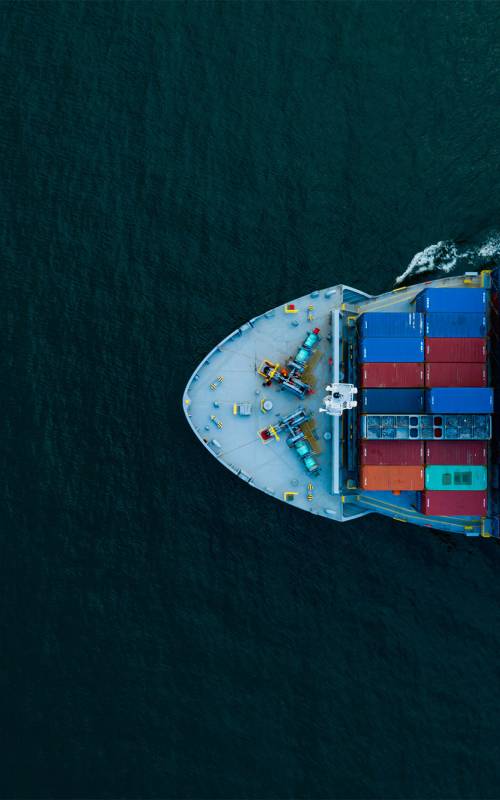Building materials transport: Because no two materials are the same
From wood to steel products, from bricks to security doors - the range of materials you need for your construction projects is wide. This is where our expertise comes in.
Calmness, skill and precise planning: Sea freight logistics for building materials requires a clear concept in which every detail is right. Temperature-sensitive adhesives, heavy steel beams or fragile sanitary ware - each material has its own requirements for packaging, handling and transport method.
-
How is the integrity of your delicate glass panes or ceramic tiles maintained during transport across the ocean?
-
Which container solution is best for your bulky window frames or scaffolding?
-
How do you load your heavy steel products or concrete elements safely?
This is just a small selection of the questions that arise when shipping building materials. You want a logistics partner that ensures the integrity of your goods and at the same time finds the most efficient transport method - regardless of whether it is for bulk goods such as building blocks and bricks or special products such as thermal insulation materials and anti-corrosive agents.
Would you like some examples?
Do you want to transport bulk goods such as sand, gravel or cement by ship? Then bulk containers are the means of choice. Equipped with special loading and unloading devices, they not only enable efficient handling, they also reduce material loss to a minimum.
Or do you want to ship bulky materials such as windows, doors or scaffolding overseas? In this case, open-top containers or flat racks are our means of choice. Open-top containers are loaded from above and are particularly suitable for tall or bulky goods. Flat racks, with their foldable end walls, offer maximum flexibility for extra-wide or extra-long building materials.
Anyone who transfers hazardous goods such as certain paints, varnishes or anti-corrosive agents is operating in a highly sensitive area. This is where our IMDG Code (International Maritime Dangerous Goods Code) expertise comes into play. A highly sensitive area in which safety always comes first. Sea freight forwarding maneuvers you safely through the sea of dangerous goods regulations. From storm-proof packaging to waterproof document logbooks - your goods always stay on course and reach their destination port safely.
Transway: Because we know what matters
It's hard to find a patented solution in the world of building materials. However, based on countless successfully completed customer orders, solutions have emerged that have proven to be safe, fast and economical. And because the decisive factors often lie in the details, you are looking for a sea freight forwarding company that is familiar with the conditions of the industry, has partners in every corner of the world and offers you a transport solution that is precisely tailored to your requirements.
Is that exactly what you are looking for? Then we should talk. Request your individual offer now!
Why you should work with us
Wood products require adequate ventilation, metal sheets must be protected from moisture, fasteners require secure packaging. Our team has a deep understanding of the specific requirements of different building materials. The result: your goods not only reach their destination on time, they arrive in pristine condition - ready for immediate use on your construction project.
Whether it's precast concrete parts weighing tons or delicate glass elements, whether it's bulk goods or hazardous materials - we know the intricacies of every building material and put together the perfect transport package for you. Our solutions adapt to your materials, not the other way around. This means that every building block ends up safely where it's needed - just-in-time, of course.
Global partnerships and state-of-the-art tracking technology navigate your construction materials through any current. From loading to arrival, we continuously optimize your sea route. The result? Shorter transit times, lower costs and the certainty that your cargo always stays on course.
From loading at the port of departure to arrival at your construction site - you always have a direct line to your goods along the entire transport chain. What do you do if the sea is stormy and you cannot navigate, or if customs clearance is delayed? We react immediately and inform you proactively. This way you can keep control of your schedule without having to be on site yourself. Your project continues while we take care of the logistical challenges.
Flexibel auf Ihren Bedarf eingestellt
short-term solutions
When an unexpected need arises on an ongoing construction site, every minute counts. Experienced employees are just as important here as a global network of partners. This interaction reliably handles even short-term requests and gets your building materials to their destination quickly and safely - regardless of whether it is ready-mixed concrete, floor coverings or corrosion protection agents.
Long-term strategy
Regular sea freight transport of building materials requires well thought-out logistics concepts - especially when wood products need to be protected from moisture, thermal insulation materials need to be compactly packed or connecting elements need to be sorted precisely. The right strategy takes all factors into account: from choosing the right container to the optimal route to complete tracking documentation. Sophisticated monitoring makes every transport transparent and shows optimization potential. This is how the logistics chain develops step by step - perfectly tailored to your processes and delivery dates.
What makes us different from other forwarding companies?
Large freight forwarding companies
- Rigid organisational structures - inflexible
- Changing contact persons
- Hotline
- Slow response time
- Lack of transparency

- Wide range of suppliers and transport solutions
- Permanent contact persons along the entire transport chain
- Direct dialling
- Fast response time
- Information on any status, at any time``
over 346 customers have already trusted us
FAQ on sea freight transport of building materials
Solid goods such as steel beams, precast concrete parts or natural stones, palletized goods such as bricks, tiles or insulation materials - the range of building materials that are transported by ship is impressive. And that is just a small selection of the variety of building materials that are sent by sea freight.
In addition, there are bulky goods such as windows, doors or facade parts and bulk goods such as sand, gravel and cement. Liquid materials such as paints, varnishes or binding agents are also part of our portfolio of corrosion protection agents, which are often classified as dangerous goods.
As such, steel products such as metal sheets, connecting elements or fastening technology do not have to be labeled, nor do wood, wood products, glass and ceramics.
The top priority is to protect the cargo from external influences such as extreme temperatures or humidity. Air-conditioned containers, special packaging, drying agents, special coatings or protective films are used here.
With heavy materials such as steel beams or concrete parts, the load must be distributed evenly in the container, while fragile goods such as tiles or glass require shock-absorbing packaging and safe stowage.
Paints, varnishes or solvents. They all fall under the category of dangerous goods. But be careful: not all dangerous goods are the same. Depending on their chemical composition and properties, these materials are subject to varying degrees of strict transport regulations. What applies to one product does not necessarily apply to another. Our experts know the subtle differences and ensure that each material is transported safely and in accordance with regulations in accordance with its specific requirements.
When goods are transported by sea, not only must various regulations be complied with, but a large number of documents must also be provided.
When transporting building materials by sea, the following main documents are usually required:
• Bill of Lading: Nothing can happen in the maritime trade world without this document. Issued by the shipping company or freight forwarder, it confirms ownership of the goods and sets out the terms of the freight contract. At the same time, it serves as a confirmation of receipt for the receipt of the goods. Depending on the type of shipment, the bill of lading can be presented as an original bill of lading, bill of lading or seaway bill for faster transactions.
• Commercial invoice: This contains detailed information about the goods transported, including prices, quantities and currency. Prepared by the exporter, it is the central document for customs clearance.
• Packing list: The packing list plays a central role in both the transport and customs clearance of building materials. It provides a detailed overview of all freight components and thus ensures the completeness of the delivery. During the transport process, it serves as an indispensable tool for identifying the various building components. Upon arrival at the destination, the packing list acts as an important control tool: it enables a thorough inspection of the goods delivered and ensures that all building materials have arrived complete and in the correct version.
• Certificate of Origin: A document issued by the exporter, it is a key element in international trade in building materials. It officially confirms the origin of the products and plays a crucial role in customs clearance. This certificate allows importers to benefit from customs concessions or exemptions stipulated in international trade agreements. The certificate of origin also serves as proof of authenticity, particularly for high-quality or specialized building materials. It protects against counterfeiting and gives buyers the certainty of purchasing authentic materials - an aspect that plays an important role in the construction industry, where quality and origin are often closely linked.
• Insurance Certificate: Issued by the insurance company, it is essential for the sea transport of building materials. It acts as binding proof of existing insurance cover for the entire duration of the transport. This certificate goes beyond a mere confirmation: it provides precise information on the insurance policy, details the scope of cover and quantifies the amount of the insured sum. This document is particularly important for sensitive or high-value building materials such as glass facade elements, special insulation materials or custom-made components. It gives everyone involved the security that adequate financial protection is guaranteed in the event of transport damage or loss, which can be crucial given the often considerable values in the building materials trade.
• Customs documents: Vary depending on the import and export country and include various forms such as customs declarations and import permits. For building materials, the correct classification according to the Harmonized System is crucial, especially for innovative building materials or special products.
In addition, depending on the type of building materials, other specific documents may be required. These include safety data sheets for chemical building materials, fumigation certificates for wood products or certificates of conformity for technical components. The exact requirements depend on the specific type of materials, the transport conditions and the legal regulations of the countries involved.
Reuse and recycling. A topic that is also playing an increasingly important role in sea transport. Increasingly strict sulphur limits or new ballast water regulations: complex requirements that require in-depth knowledge and insight. Costs are rising, route planning is becoming a tricky puzzle. Nevertheless: the top priority is to deliver your building materials not only on time, but also in an environmentally friendly manner.
Planning becomes precision work, especially when transporting insulation materials or lightweight facade elements. Every route must now be coordinated with ballast water change zones, without losing sight of delivery times. The packaging of sensitive materials such as tiles or sanitary ceramics also requires new approaches: where disposable films were previously used, innovative, recyclable solutions are now in demand.
The effects extend to the ports: stricter noise protection requirements limit loading and unloading times, which requires a rethink, especially for bulk goods such as sand or gravel. At the same time, demand for sustainable building materials is increasing. The transport of wood from certified forestry or recycled building materials places new demands on documentation and traceability throughout the entire supply chain.
Our real-time tracking service documents the status of your goods seamlessly. As soon as the goods are loaded, you will receive an individual tracking number. This allows you to view the current position and status of your freight online at any time. Our system enables you to monitor the entire transport process from collection to arrival at the destination.
Ask for the freight costs here without obligation!
Our young and highly motivated team is there to help you!
- Free of charge & without obligation
- quick & easy









